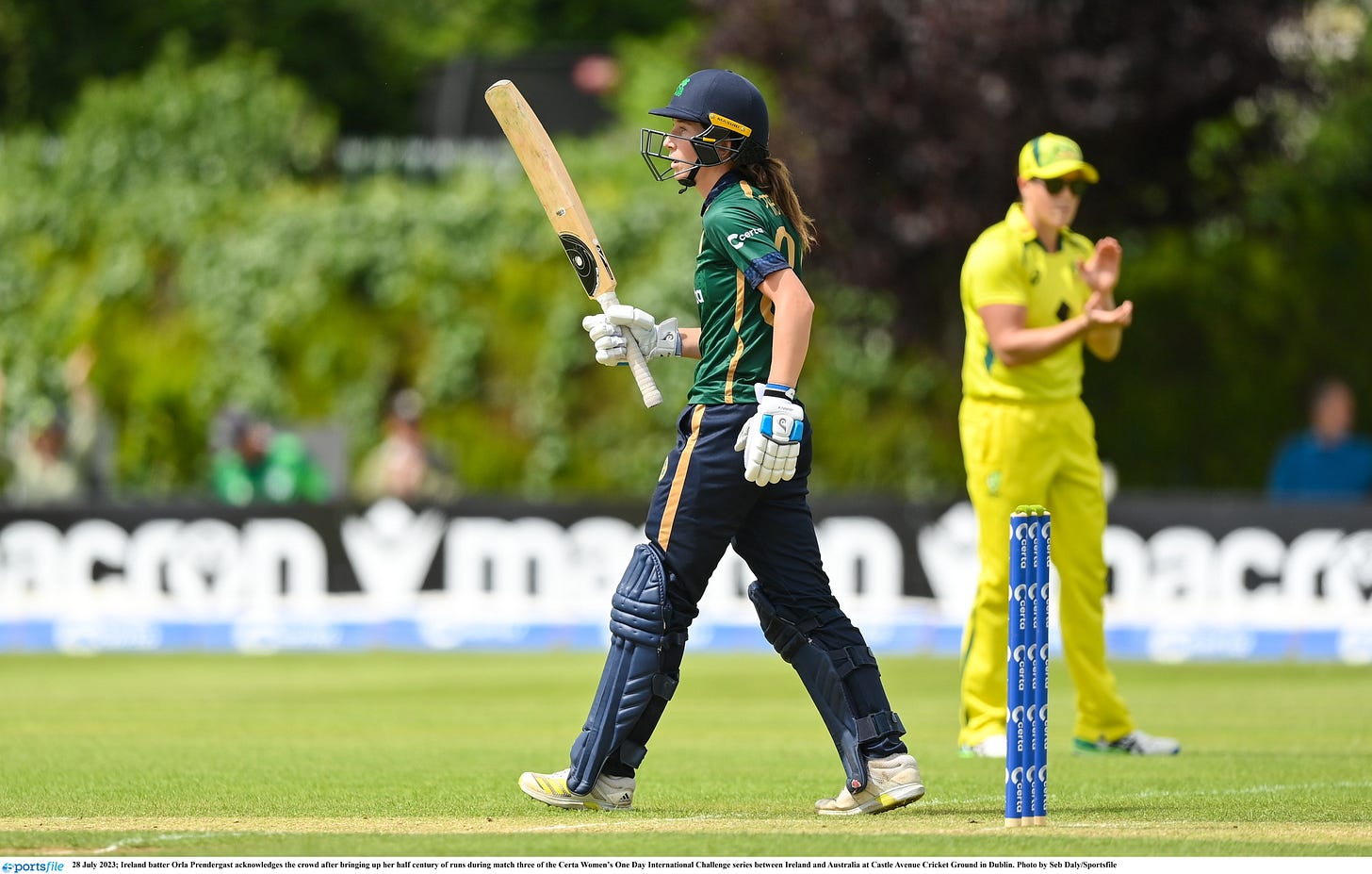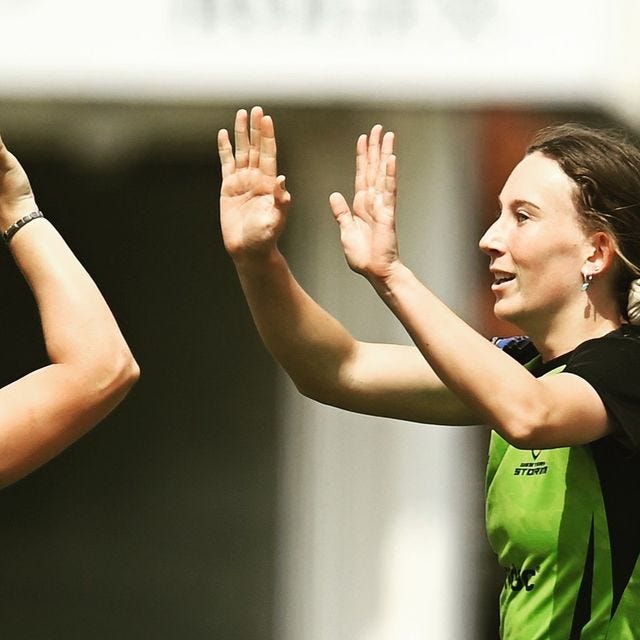Why is Orla Prendergast's new out-swinger so important?
Variety, new coaching and the benefit of playing away from Ireland
What do Orla Prendergast and Stuart Broad have in common?
Probably not a lot, but they both developed an out-swinger ahead of entertaining the Aussies this summer.
Broad’s version was full of his usual fanfare. The Ashes build-up was dominated by talk of a delivery he doesn’t generally bowl, an out-swinger designed especially with Marnus Labuschagne and Steve Smith in mind.
To be fair to him, it worked. The first ball Labuschagne faced in the first Test in Edgbaston was a Broad out-swinger which he duly nicked.
Prendergast’s new delivery came with much less hype, unsurprisingly. In fact, she probably wouldn’t have spoken about it if not asked directly following the 2-0 series defeat to Australia last week.
The Pembroke all-rounder is traditionally an in-swing bowler to right-handed batters. Despite her pace, her action is what traditionalists would call a ‘weak’ one for a right-arm fast bowler, causing her to fall over to her left hand side. Her wrist doesn’t stay strong behind the ball as a result, leading the ball to naturally hoop back in.

It’s a very common action amongst the Ireland squad. Ava Canning and Arlene Kelly are similar, albeit they bowl at reduced speeds.
Prendergast could have, and almost certainly did, bowl the ball sooner, but the first time I saw her try an out-swinger was up in Waringstown during a Super Series game on July 16th.
She did bring the new delivery with her down to Clontarf a fortnight later, bowling it frequently to both left and right handers as well as her stock in-swinger in the Australia series. It did bring some success during the second ODI, moving late back into the left-handed Phoebe Litchfield where she flicked straight to Gaby Lewis at mid-wicket.
While it did swing onto the middle of Litchfield’s bat, perhaps the late movement forced her to fall over just a touch, meaning she wan’t in full control of the aerial stroke.
As a whole, the return with the new delivery was a mixed bag. Across the two games in the series, Prendergast bowled eight wides. These came from both out and in-swingers, but she looked to struggle at times when trying to adjust her line based on what delivery she was trying to bowl, often starting in-swingers too straight and out-swingers too wide.
She probably also changed between the two deliveries too frequently. On commentary during the second ODI (the first one that wasn’t washed out), Isobel Joyce expressed the opinion that Prendergast should use the new delivery as more of a surprise ball, to set the batter up. Think of the old Jimmy Anderson method of three out-swingers followed by a booming in-ducker.
Prendergast herself acknowledged she hasn’t figured out yet when is the perfect time to use her new weapon. “No, not yet. It’s very much a work in progress but it’s an exciting process and one I want to keep working on,” she said after the series.
“I would love to have a bit more control over it. I think, generally I bowl big in-swingers but against good players you need more than that. I’ve been thinking about trying to challenge players on both sides of their bat.”
Prendergast also suggested that the idea to develop the delivery came while playing with the Western Storm during a recent stint in the UK.
“I did a good bit of that over in Bristol with our bowling coach over there. Coming back, I haven’t really had a lot of time to just train and bowl, get loads up and think about how to go about it. It’s been do a bit here, a bit there, it’s hard when you’re playing matches all the time but definitely something I’ll look to keep working on.”
“The other thing is I’ve looked to bowl the bouncer. It’s to try and add more to my armoury.”
While Prendergast didn’t bowl too many bouncers to Australia on a slow-ish Clontarf pitch, she certainly did during the aforementioned Super Series game in Waringstown. Christina Coulter-Reilly of the Scorchers was the unfortunate batter who had to adapt to a level of chin music not normally seen in Irish domestic cricket.
The reasoning behind Pendergast adding more strings to her bow make sense. For all the occasions where she cleans up batters with beautiful, fast in-swingers through the gate in domestic cricket, that won’t always fly at international level. For one, she can’t threaten batters as much with her pace given she all of a sudden isn’t the quickest bowler on display. Equally, the obvious point is true that elite batters can set themselves up for major success when they know what’s coming.
After announcing herself to an international audience with the bat during the World Cup, Prendergast is clearly trying to make up the difference with the ball. It was noteworthy how, looking at scorecards during her stint with Western Storm, she was probably seen more as a batter who can offer a decent option with the ball. She may be Ireland’s strike bowler, but that isn’t the case when she plays elsewhere, for now.
There are two ways of looking at Prendergast saying that she worked on her new out-swinger while not playing with Ireland. Option one: it is a positive example of the benefit of opening players up to new ideas, exposing them to other coaches who have different strengths and ways of thinking about the game.
Given upcoming overseas stints for Irish players, working with and learning from different coaches is topical. Harry Tector (for just one game, for whatever reason) and Curtis Campher are playing in county cricket’s 50-over competition. Josh Little is going back to the Manchester Originals in the Hundred while Lewis and Prendergast herself will be going to the Caribbean Premier League later this month.
Option two: it isn’t rocket science to say that a bowler who bowls exclusively in-swing needs more variety to be an elite international bowler. Arlene Kelly after all has her yorker to go with her natural movement in, and she’s been Ireland’s most effective bowler over the last 12 months.
Why has it taken until Prendergast travelled to the UK to be exposed to such thinking? Does it reflect somewhat on the coaching she receives in the Irish set-up? I’ll leave that up to others to form their opinion.
Either way, it shows that Prendergast got something positive out of her time in Bristol. An argument, if ever one was needed, of the benefit Irish players in particular get when they go to countries that have top class facilities, regular quality fixtures and different coaching voices, be they better equipped than what is at home or not.







